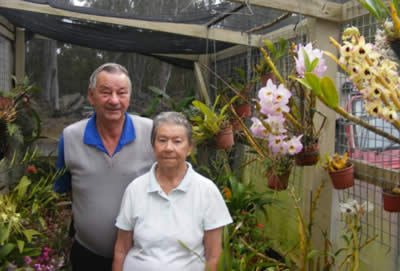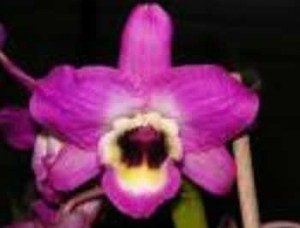Growing Softcane Dendrobiums
By Sandy Anderson – one of our life members.

A recent photo of Sandy and his wife Ollie – and he still grows some softcane Dendrobiums
Sandy was a member of the Coffs Harbour Orchid Society and was president in 1986 and 1987. For many years Sandy ran an orchid business – Bananacoast Orchids – which sold softcane Dendrobiums. This article is taken from the booklet “Orchid Culture by leading North Coast Growers”
Soft Cane or Nobile type Dendrobiums must surely be the easiest of all exotic orchids to grow and flower and the range of colours available is unsurpassed by any other type or genus of orchids.
Early attempts by some growers were somewhat disappointing with plants making aerial growths (kakis) instead of flowers.
These notes are intended to help people overcome that problem and to encourage the new growers to try them. There are no special conditions needed, just an understanding of their basic requirements.
We believe that by far the most important aspect of their culture is that they have a definite and set time to grow and an equally set time not to grow. When this is properly understood, the rest is relatively simple.
The species from which our modern hybrids are derived were mainly from an area in the lower Himalayas and associated hills in India and the western side of the mountain ranges which run down the Malay Peninsula and usually at an altitude of 3000 to 4000 feet (1000-1200 M) In these locations they are subjected to extremes of heat, cold and heavy rainfall- so don’t pamper them.
Summer temperatures of 40 degrees and winter down to 0 degrees (canes must not be allowed to freeze) are tolerated equally well if other conditions are looked after.
The time to look for good flowers is when the old flowers are still on the plant. In other words, you need to grow a good lead during the summer to be able to get good flowers from it next spring. While still flowering or shortly afterwards, the new leads will emerge and start to grow. As soon as they start to show signs of wanting to grow and not just sit there (usually when it is 3-4 inches long) that is the time to start your feeding programme.
Fertilize according to the rate of growth of the new leads, as the growth rate accelerates, so increase the fertilizer rate. As a guide we start fertilizing on the 1st of November, and gradually increase frequency from once per week to twice weekly, by about Christmas, then maintain that rate till the end of February or early March when we stop completely.
No more fertilizer is given until the next season, by that time the new lead has reached its maximum height and only needs to fill out the top 2 or 3 nodes to finish its growth.
The fertilizer that has produced the best results for us is Campbell’s A (yellow) N P K 11-13-16 at full strength 3 gms per litre.
All dendrobiums have the capacity to produce new growths from their nodes (keikis). This is one of nature’s ways of ensuring survival of the species. A plant will use this method of reproduction if placed under stress such as when the root system has been damaged or rotted, or when conditions are not ideal. I have seen 2 collections destroyed by using them to provide extra shade for Cattleyas etc. during summer under a fibreglass roof (conditions there were too hot and too dry)
All canes shrivelled and keikis developed all over them. Using any fertilizer containing nitrogen on the plant when they are not in active growth will also produce the same results as will trying to grow them under too much shade.
We grow all our dens in shade house of 30% or 50% shade, even our small plants, although these could be grown under 70% all right. It is important to provide plenty of light for flowering size plants especially in the winter months. In fact from about the end of April they could be left in full sun until the buds appear, but remember that the higher the light level the more attention needs to be given to watering in hot weather. Plenty of air movement around the plants helps to reduce the temperature of the leaf surfaces and prevents burning.
During the summer period which corresponds with the “wet” seas in the region where they originated plants require copious quantities of water and as high humidity as it is possible to provide. After the growth has finished in the early autumn, watering can taper off so that by July it should only be necessary to water at 5-7 day intervals if weather is dry, increasing again as the flowers start to develop.
POTTING
Size of pots, type of potting material and water frequency are all inter related. In brief, the smaller the pot and the more open the mix, the more often watering will be needed. However, don’t use larger pots or finer mixes than necessary. We grow our single flowering cane plants in 100mm (4”) pots and a mix of 2/3 Casuarina bark ( ¼” to ½” grade and1/3rd perlite and water well in the late afternoon daily during summer. On hot days (over 30 degrees C) we give a 4 to 5 minute watering once or twice during the day, mainly to increase the humidity.
Repotting is done as soon after flowing as possible and before the roots on the new leads can be damaged. If any organic material is used in the mix such as bark etc. 2 years will be about its limit.
When dividing or trimming old growths at re potting time we leave 3 years growth on the plants. These old canes act as a reservoir for food for new growth.
PEST AND DISEASES
These orchids are subject to attack by pests that growers know only too well and are treated with insecticides appropriate to the pest. The exception to that is leaf spotting. This is caused by a fungus and we control it completely with a fungicide spraying every week. We are still using Captan, but when our supply runs out we will try Dithane 45 which was recommended to us by the Agricultural Department
FLOWERING
Soft canes Dens need a cooling off to initiate flower buds. Yamamoto says a month of nights at about 10 deg is needed, but we believe 13 deg is cool enough. If plants are placed in a good position where good light reaches the full length of the flowering cane at bud initiation time, you will find that they develop over a greater length. If crowded together at that time flowering will be confined to only the top sections.
SOME HELPFUL HINTS
A porous floor covering that can be kept wet. Sawdust or wood chips are good or some sort of plant growing on the floor will improve humidity. The closer your soft canes are grown to the floor the better. Hanging plants to the roof provides the lowest humidity.
Polystyrene boxes turned upside down, with holes cut in them to the pot size with a sharp knife are good to hold plants upright and trap moisture in the root area -a definite plus.
It will also help if plants are grown fairly close together for the hot growing season but space wider in autumn for better flowering.
Flowers are long lasting but this can be extended by keeping the plants cool and the flowers dry when watering.
TO SUM UP
- Fertilize and water freely all summer.
- Stop fertilizing not later than mid March
- Water all year if conditions are dry.
- Grow under plenty of light and air movement
- Sit back and enjoy the results
